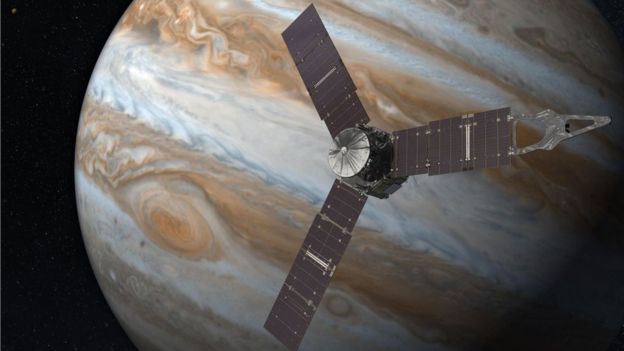Tech
Nasa Probe Arrives In Jupiter Orbit
The US space agency has successfully put a new probe in orbit around Jupiter .
The Juno satellite , which left Earth five years ago , had to fire a rocket engine to slow its approach to the planet and get caught by its gravity .

A sequence of tones transmitted from the spacecraft confirmed the braking manoeuvre had gone as planned .
Receipt of the radio messages prompted wild cheering at Nasa ’ s mission control in Pasadena, California .
“ All stations on Juno co – ord , we have the tone for burn cut- off on Delta B ,” Juno Mission Control had announced . “ Roger Juno , welcome to Jupiter . ”
Scientists plan to use the spacecraft to sense the planet’ s deep interior . They think the structure and the chemistry of its insides hold clues to how this giant world formed some four – and – a -half- billion years ago .
Engineers had warned in advance that the engine firing was fraught with danger .
No previous spacecraft has dared pass so close to Jupiter ; its intense radiation belts can destroy unprotected electronics , reports the BBC .
One calculation even suggested the orbit insertion would have subjected Juno to a dose equivalent to a million dental X – rays.
But the probe is built like a tank with titanium shielding, and the 35 – minute rocket burn appeared to go without a hitch.
While the radiation dangers have not gone away , the probe should now be able to prepare its instruments to start sensing what lies beneath Jupiter ’s opaque clouds .
Tuesday ’ s orbit insertion has put Juno in a large ellipse around the planet that takes just over 53 days to complete .
A second burn of the rocket engine in mid – October will tighten this orbit to just 14 days . It is then that the science can really start .
This will involve repeat passes just a few thousand kilometres above the cloud tops .
At each close approach , Juno will use its eight remote sensing instruments – plus its camera – to peer down through the gas planet ’ s many layers, to measure their composition , temperature, motion and other properties .
A priority will be to determine the abundance of oxygen at Jupiter . This will be bound up in its water .
“ How much water Jupiter has tells us a lot about where the planet formed early in the Solar System, ” explained team – member Candy Hansen .
“ We think that Jupiter may not have formed where it is today, and if it formed further away or closer in – that tells us a lot about how the Solar System in general formed . Because when we look at planets around other stars we see quite a menagerie of possibilities .”
Follow us on social media:-

 Celebrity Gossip & Gist1 day ago
Celebrity Gossip & Gist1 day ago“Why It’s a sin to marry only one or two wives” – Nollywood actor, Uwaezuoke advises men
-

 News1 day ago
News1 day agoINEC Speaks On Manipulating Edo Governorship Election
-

 Lifestyle1 day ago
Lifestyle1 day ago“Them carry their beef enter Live TV” – Reactions as two female presenters drag with each other during a live broadcast, clip goes viral (Watch)
-

 Crime1 day ago
Crime1 day agoTwo Anambra revenue collectors set ablaze by irate mob for causing de@th of innocent bystander





